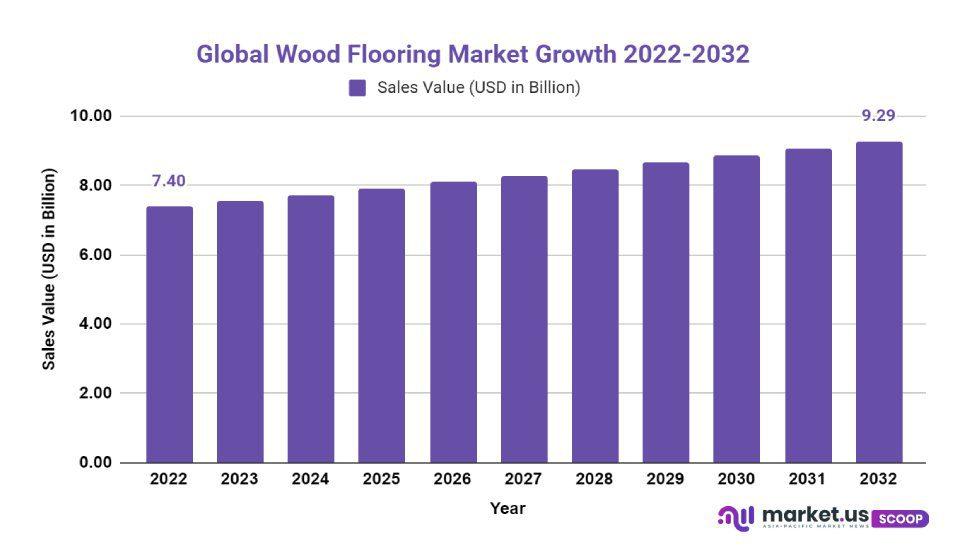Wood Flooring To Be The Future of Flooring in the Construction Industry, says Market.us
At Market.us Scoop, we strive to bring you the most accurate and up-to-date information by utilizing a variety of resources, including paid and free sources, primary research, and phone interviews. Our data is available to the public free of charge, and we encourage you to use it to inform your personal or business decisions. If you choose to republish our data on your own website, we simply ask that you provide a proper citation or link back to the respective page on Market.us Scoop. We appreciate your support and look forward to continuing to provide valuable insights for our audience.
Wood flooring is expected to continue its rise in popularity due to its widespread use in construction projects. It is made from natural materials, wood flooring is durable and resistant to everyday abrasion. Furthermore, wooden floors often boast a more beautiful aesthetic than other types of flooring.
Wood flooring is popular in both residential and commercial settings due to its renewable nature. As more buildings, age, renovations, maintenance work, and remodeling will become necessary – driving the sector’s moderate growth forecast over the coming years.
According to research by Market.us, “The Global Wood Flooring Market was valued at USD 7.4 billion in 2022. It is expected to grow at a 2.3% CAGR and expected to reach USD 9.3 billion in 2032 during the forecast period 2023 and 2032.”

Anurag Sharma, a senior research analyst at Market.us, said, “With the rising construction activity in the country, demand for wood flooring is expected to rise. This market is being driven by an uptick in luxury living spaces, hotels, homes, and other hospitality facilities.”
The wood flooring market is constantly shifting with changing consumer preferences and trends. One such trend is the increasing demand for sustainable and eco-friendly options. As consumers become more environmentally aware, they seek products manufactured using sustainable practices and materials; as a result, manufacturers are offering more eco-friendly choices like bamboo, cork, and reclaimed wood flooring options.
Another prominent trend in the wood flooring market is the popularity of wider planks and longer boards. Consumers prefer wider planks because they provide a modern, luxurious aesthetic while longer boards make rooms appear larger and airier. To meet this need, manufacturers are providing these boards in various finishes and styles.
Non-resilient flooring has become popular due to its cost-effective alternative without sacrificing aesthetic properties. Engineered Wood and its laminates have become highly sought-after choices within distribution channels due to their compressed wood price point which leaves a natural finish.
Due to government restrictions on outdoor and team-based athletic events, the spread of coronavirus has drastically reduced sporting activity. To stay fit and maintain a healthy lifestyle, many have turned to indoor sports like badminton or squash instead.
Indoor venues require flooring materials with strong impact resistance as well as moisture resistance – such as those found in stadiums or sporting domes – which also look beautiful while meeting all these requirements.
Wooden flooring is a long-term investment that meets an increasing need. The market is being driven by changes in living standards, rising investment in hotel construction projects, rising construction activities, as well as renovations of existing buildings across residential and commercial sectors.
Over the next few years, wooden floor demand will be further fuelled by interior decor items like light fixtures and furnishings; rising spending on luxury goods; and an increase in global luxury hotel construction projects.
The wood flooring market is a competitive and rapidly-evolving industry that is heavily affected by various factors. One primary constraint on growth is the supply and cost of raw materials.
Wood is an abundant natural resource that can be affected by environmental and economic events like deforestation, forest fires, or changes in government policies resulting in fluctuations in wood prices that make it difficult for manufacturers to sustain consistent pricing or profitability levels.
Another significant limiting factor is the growing popularity of alternative flooring materials such as laminate, vinyl, and engineered wood flooring. These products tend to be cheaper, more durable, and easier to install – making them increasingly appealing to consumers looking for cost-effective yet low-maintenance options.
Nikhil Randhe
I am Nikhil, working as a Digital Marketing Associate at Prudour Pvt Ltd. I did a Master's in Digital Marketing and worked in a Core SEO team. I an passionate about Digital Marketing with skills such as Search Engine Optimisation, Search Engine Marketing, Google Analytics, etc.
Latest from Author
- Backup power made easy thanks to home generators market, says Market.us
- Fashion Meets Function in the Rapidly Growing Condom Market, says Market.us
- Mobile Gamma Cameras Market is an Advancing Imaging Technology for Flexible Medical Diagnostics, says Market.us
- The Premiumization of the Whiskey Market Raising the Bar For Key Players, says Market.us
- Silane Coupling Agents Market To Be The Key to Stronger Materials, says Market.us